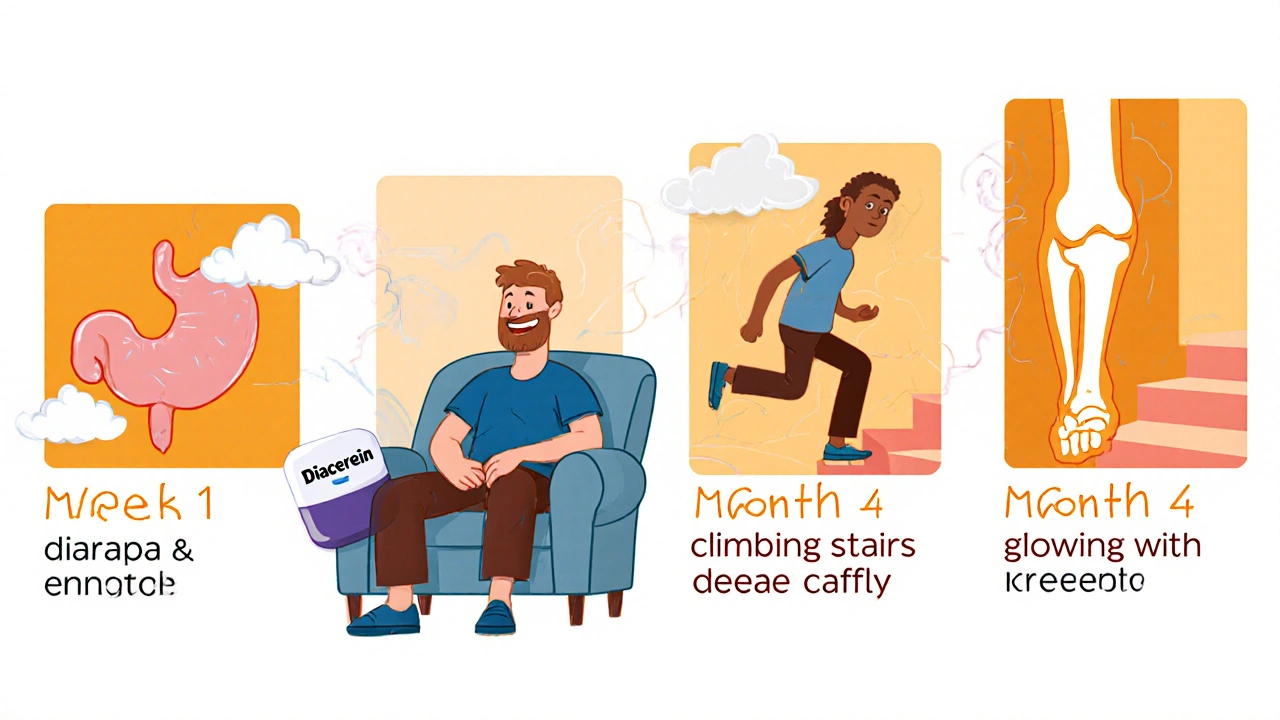Diacerein isn’t a drug you hear about often in everyday conversations, but for people living with osteoarthritis, it’s been a quiet player in managing pain and slowing joint damage for decades. Unlike common painkillers that just mask symptoms, diacerein works at the root of inflammation-targeting the biological processes that break down cartilage over time. If you’ve been told to try it, or you’re curious why your doctor recommended it over ibuprofen or glucosamine, understanding how diacerein actually works might help you decide if it’s right for you.
What diacerein is and how it’s used
Diacerein is a prescription medication classified as a disease-modifying osteoarthritis drug (DMOAD). It’s not a pain reliever like acetaminophen or an NSAID like naproxen. Instead, it’s designed to slow down the progression of osteoarthritis, especially in the knees and hips. The active ingredient is a compound derived from anthraquinone, a natural substance found in plants like rhubarb and aloe. In the body, diacerein is quickly broken down into rhein, which is the real active form doing the work.
It’s usually taken as a 50 mg capsule once or twice daily, often with food to reduce stomach upset. People typically take it for months before noticing real benefits. Unlike fast-acting painkillers, diacerein doesn’t give you immediate relief. But studies show that after 3 to 6 months of consistent use, many users report less joint stiffness, improved mobility, and reduced need for other pain medications.
How diacerein fights inflammation
The magic of diacerein lies in how it blocks interleukin-1 beta (IL-1β), a key inflammatory messenger in the body. In osteoarthritis, your joints don’t just wear out from use-they’re actively attacked by inflammation. Cells in the joint lining, called synoviocytes, pump out IL-1β, which then tells cartilage cells (chondrocytes) to stop repairing themselves and start breaking down collagen and proteoglycans. This is what leads to the thinning of cartilage and the bone-on-bone pain people feel.
Diacerein’s metabolite, rhein, steps in and blocks IL-1β from binding to its receptors. Without that signal, chondrocytes don’t go into destruction mode. Instead, they keep producing the proteins that keep cartilage strong and cushioned. This isn’t just about reducing swelling-it’s about changing the biological environment inside the joint to favor healing over decay.
A 2019 meta-analysis published in Osteoarthritis and Cartilage reviewed 12 randomized trials involving over 3,000 patients. The results showed that diacerein significantly reduced joint space narrowing-a key sign of structural damage-compared to placebo. That’s rare in osteoarthritis treatments. Most drugs only help with symptoms. Diacerein actually changes the disease course.
How it compares to other osteoarthritis treatments
Let’s say you’re choosing between diacerein, glucosamine, and NSAIDs. Here’s how they stack up:
| Treatment | Primary Action | Time to Effect | Structural Benefit | Common Side Effects |
|---|---|---|---|---|
| Diacerein | Blocks IL-1β, protects cartilage | 3-6 months | Yes | Diarrhea (up to 30%), abdominal discomfort |
| Glucosamine | Provides building blocks for cartilage | 2-8 weeks | Unclear, minimal evidence | Mild bloating, nausea |
| NSAIDs (e.g., ibuprofen) | Reduces pain and inflammation temporarily | Hours | No | Stomach ulcers, kidney strain, high blood pressure |
| Corticosteroid injections | Strong local anti-inflammatory | Days | No | Joint damage with frequent use, blood sugar spikes |
Glucosamine is popular, but large studies like the GAIT trial found it offers little more than placebo for most people. NSAIDs give quick relief but come with long-term risks. Diacerein sits in the middle: slower to act, but with a unique ability to protect joint structure. It’s not for everyone, but for someone who wants to avoid daily painkillers or isn’t a candidate for injections, it’s a compelling option.

Who should consider diacerein
Diacerein is most effective for people with moderate osteoarthritis who still have some joint space left. If your X-ray shows bone grinding on bone with no cartilage remaining, diacerein won’t rebuild it. But if you’re in the early to mid-stages-where pain comes and goes, stiffness lasts after sitting, and movement feels stiff but not impossible-it can help you hold onto function longer.
It’s also worth considering if you have other health issues that make NSAIDs risky. For example, if you have a history of stomach ulcers, kidney disease, or heart failure, NSAIDs can be dangerous. Diacerein doesn’t affect the stomach lining the same way, though it can cause diarrhea. That’s usually mild and improves after a few weeks. Taking it with meals helps.
People with liver disease should avoid it. Rhein is processed by the liver, and in rare cases, diacerein has been linked to liver enzyme elevations. Doctors usually check liver function before starting and again after 3 months.
What to expect when you start taking it
When you first begin diacerein, don’t expect miracles. Many people feel worse in the first 2-4 weeks. Diarrhea is common-up to 1 in 3 users experience it. It’s not dangerous, but it’s annoying. Staying hydrated and eating fiber-rich foods helps. Some people take a probiotic to balance gut bacteria.
After 8 weeks, you might notice small improvements: climbing stairs feels easier, you don’t need to stretch as much in the morning. By month 4, many report being able to walk longer distances without pain. The real win? You’re not just managing pain-you’re protecting your joints for the long haul.
One study followed patients for 3 years. Those on diacerein had 40% less joint space loss compared to those on placebo. That’s not just symptom control. That’s disease modification.

Limitations and safety concerns
Diacerein isn’t approved in the U.S. or Canada, though it’s available in Europe, Australia, and parts of Asia. That’s partly because of the diarrhea issue and partly because regulatory agencies wanted more long-term safety data. But in countries where it’s used, it’s been on the market since the 1980s with a solid safety profile when monitored.
The biggest risk is liver toxicity. Less than 1% of users develop significant liver enzyme changes, but it’s serious enough that regular blood tests are recommended. Also, diacerein isn’t recommended for pregnant women, children, or people with severe kidney disease.
It doesn’t interact badly with most medications, but it can increase the effect of blood thinners like warfarin. Always tell your doctor what else you’re taking.
Is diacerein worth trying?
If you’ve tried painkillers and they’re not enough-or you’re tired of side effects-diacerein offers a different path. It’s not a quick fix, but it’s one of the few treatments that actually targets the biology of joint degeneration. It won’t cure osteoarthritis, but it can help you keep your joints working longer without surgery.
Think of it like a slow, steady investment in your mobility. You pay a small price in the beginning (diarrhea, patience), and over time, you gain something lasting: less pain, better movement, and slower joint damage.
It’s not for everyone. But for the right person-someone with moderate osteoarthritis, who wants to avoid long-term NSAID use, and is willing to wait a few months-it can be one of the most thoughtful choices you make for your joints.
How long does it take for diacerein to work?
Most people start noticing improvements after 3 to 6 months of daily use. Unlike painkillers that work in hours, diacerein works by changing how your joints repair themselves, which takes time. Patience is key.
Does diacerein cause diarrhea? Is it dangerous?
Yes, diarrhea is the most common side effect, affecting up to 30% of users. It’s usually mild and improves after a few weeks. Taking it with food helps. It’s not dangerous, but if it’s severe or lasts longer than 4 weeks, talk to your doctor. Staying hydrated and using probiotics can help manage it.
Can I take diacerein with other arthritis supplements like glucosamine?
Yes, there are no known harmful interactions between diacerein and glucosamine or chondroitin. Some doctors recommend combining them, especially since glucosamine may help support cartilage structure while diacerein reduces inflammation. However, always check with your doctor before mixing treatments.
Why isn’t diacerein available in the U.S.?
Diacerein isn’t approved by the FDA, mainly due to concerns about gastrointestinal side effects and the need for more long-term safety data. It’s available in Europe, Australia, Brazil, and other countries where regulatory bodies have reviewed the evidence and deemed the benefits outweigh the risks for specific patients.
Does diacerein help with rheumatoid arthritis?
No, diacerein is only studied and approved for osteoarthritis. Rheumatoid arthritis is an autoimmune disease, and diacerein doesn’t target the immune system. It’s not effective for RA and shouldn’t be used as a substitute for disease-modifying antirheumatic drugs (DMARDs) like methotrexate.
Can I stop taking diacerein once I feel better?
Stopping early may mean losing the structural benefits. Since diacerein works by slowing joint damage, not just masking pain, stopping the medication could allow inflammation to resume. Most doctors recommend continuing it as long as you’re benefiting and tolerate it well. Talk to your doctor before making any changes.
If you’re considering diacerein, talk to your doctor about your X-rays, current symptoms, and other medications. It’s not a magic pill, but for the right person, it’s one of the few tools that actually helps your joints heal instead of just hiding the pain.



Matthew King
bro i tried diacerein last year after my knee started acting up. first two weeks? pure chaos. diarrhea like i was in a war zone. but by month 3? i could walk to the store without groaning. no magic, just slow magic.